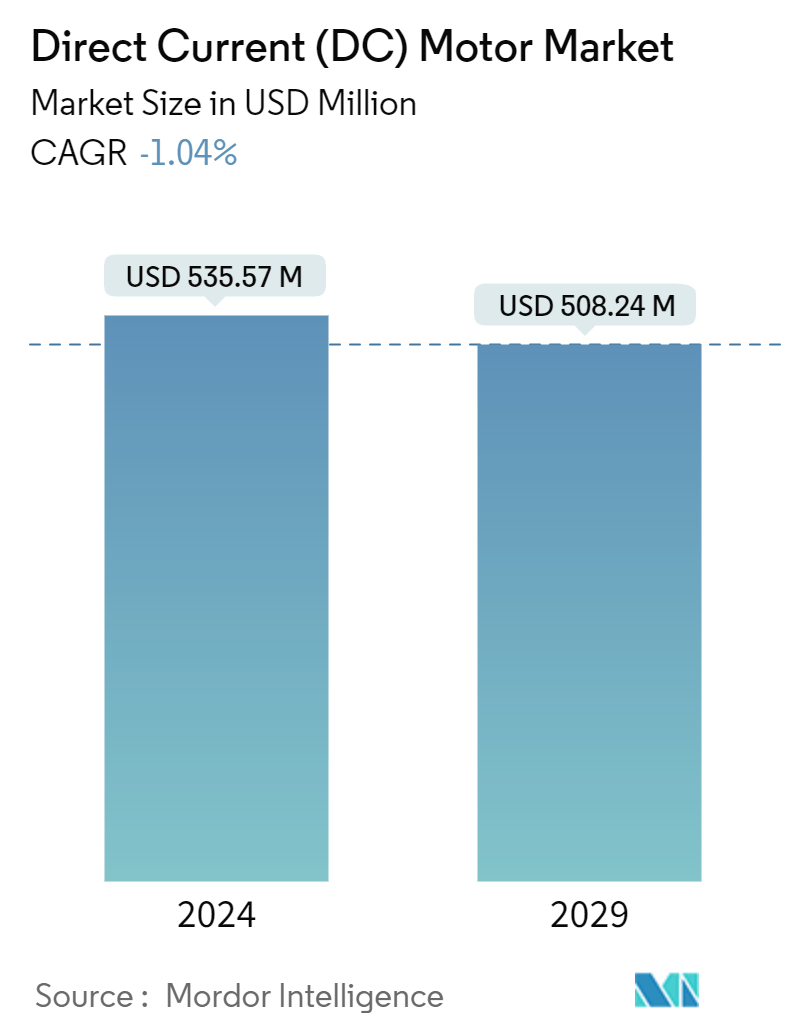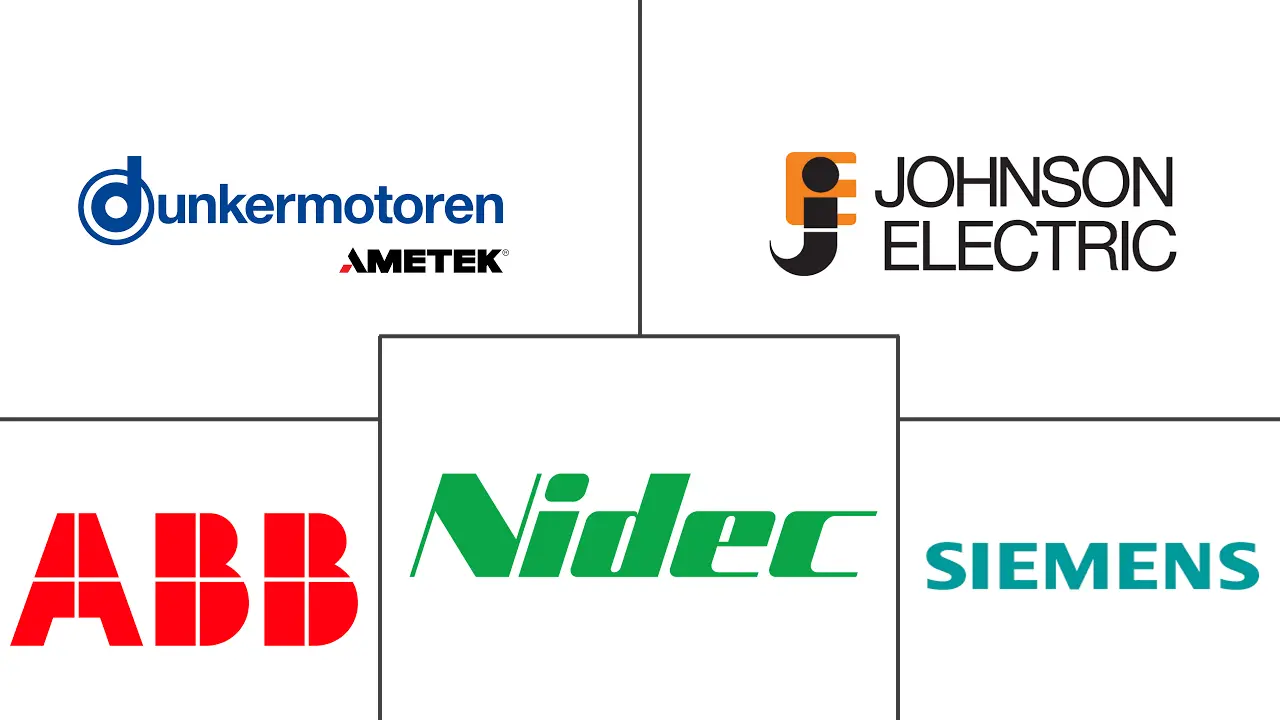Market Size of Direct Current (DC) Motor Industry

| Study Period | 2019 - 2029 |
| Market Size (2024) | USD 535.57 Million |
| Market Size (2029) | USD 508.24 Million |
| CAGR (2024 - 2029) | -1.04 % |
| Fastest Growing Market | Asia Pacific |
| Largest Market | Asia Pacific |
| Market Concentration | Low |
Major Players
*Disclaimer: Major Players sorted in no particular order |
Direct Current (DC) Motor Market Analysis
The Direct Current Motor Market size is estimated at USD 535.57 million in 2024, and is expected to decline to USD 508.24 million by 2029.
Increasing industrial automation drives the demand for DC motors, which play a vital role in automated systems by providing precise control and reliable performance. Labor shortages in emerging countries are leading to the adoption of robotics in the manufacturing industry, which is also creating demand for different types of DC motors, such as shunt motors, separately excited motors, and compound motors.
- DC motors are widely used in automobile systems for wiper motors, power seat motors, power window motors, and HVAC systems. Additionally, the growing adoption of electric vehicles is expected to support the market's growth during the forecast period. The automotive sector has witnessed a significant increase in daily units produced.
- Owing to the rising importance of occupational safety in the global regions, the government has mandated quality air management as industries such as oil and gas, mining, power generation, chemicals, and petrochemicals often involve harsh and explosive atmospheres. Thus, HVAC systems aid in creating a safe working environment by managing and controlling air circulation. With HVAC systems turning out to be an integral part of the industrial sector, DC motors are also able to create a generous demand as they are used in HVAC systems' blower motors, variable speed drives, and AHUs to achieve high efficiency in airflow systems along with in maximizing their lives.
- The automotive industry has rapidly introduced pollution-free electric vehicles (EVs). The development and improvement of EVs to replace conventional vehicles has become crucial to obtaining customer satisfaction and high-tech achievements. As per the IEA, electric vehicles are one of the driving forces in the new global energy economy that is rapidly emerging, and they are bringing about a historic transformation of the car manufacturing industry worldwide.
- Several obstacles are preventing the widespread use of DC motors. The main challenges revolve around the associated expenses, including energy costs, maintenance costs, and initial purchase costs. This is because the wound rotor and commutator of a DC motor are quite a bit more complicated than the rotor of an induction motor. They are made out of copper and iron rather than aluminum and iron. The heavier rotor of the DC motor may require more expensive bearings.
- The impact of the COVID-19 pandemic was observed on the market as various containment measures taken by governments across multiple countries, such as the implementation of lockdown, significantly impacted the growth of the industrial sector. As a result, a slowdown was witnessed in the studied market, especially during the initial phase, due to supply chain issues. However, with significant end-user industries resuming operations at total capacity, the demand for smart DC motors is anticipated to increase.
Direct Current (DC) Motor Industry Segmentation
Any group of rotating electric motors that use direct current to produce mechanical energy are known as DC motors. The most prevalent varieties rely on the forces generated by induced magnetic fields due to current passing through the coil.
The direct current (DC) motor market is segmented by type (permanent magnet and self-excited, separately excited), end-user industry (oil and gas, chemical and petrochemical, power generation, water and wastewater, metal and mining, food and beverages, discrete industries, and other end-user industries), and geography (North America, Europe, Asia Pacific, Latin America, and Middle East and Africa). The market sizes and forecasts are provided in terms of value (USD) for all the above segments.
| By Type | |
| Permanent Magnet and Self-Excited | |
| Separately Excited |
| By End-user Industry | |
| Oil and Gas | |
| Chemical and Petrochemical | |
| Power Generation | |
| Water and Wastewater | |
| Metal and Mining | |
| Food and Beverage | |
| Discrete Industries | |
| Other End-user Industries |
| By Geography | |||||||
| |||||||
| |||||||
| |||||||
| |||||||
|
Direct Current (DC) Motor Market Size Summary
The direct current (DC) motor market is experiencing a dynamic phase driven by increasing industrial automation and the growing adoption of electric vehicles. DC motors are integral to automated systems, offering precise control and reliable performance, which is crucial as industries face labor shortages and turn to robotics. In the automotive sector, DC motors are extensively used in various systems, and the rise of electric vehicles is expected to bolster market growth. Additionally, the importance of occupational safety in industries like oil and gas, mining, and chemicals has led to a heightened demand for HVAC systems, where DC motors play a vital role in ensuring efficient airflow and safety. Despite these growth drivers, the market faces challenges such as high costs associated with energy, maintenance, and initial purchases, which can hinder widespread adoption.
The market landscape is characterized by fragmentation and increasing competition among key players such as ABB Ltd, AMETEK Inc., Johnson Electric Holdings Limited, Nidec Corporation, and Siemens AG. These companies are actively expanding their market presence through strategic acquisitions and technological innovations. For instance, Franklin Electric Co. Inc. and Nidec Corporation have made significant acquisitions to enhance their product offerings and service capabilities in critical sectors like water treatment and oil and gas. In regions like China and India, the demand for DC motors is driven by factors such as smart manufacturing initiatives, rapid urbanization, and the need for wastewater treatment facilities. These trends, coupled with favorable government regulations and technological advancements, are expected to sustain the market's growth trajectory in the coming years.
Direct Current (DC) Motor Market Size - Table of Contents
-
1. MARKET INSIGHTS
-
1.1 Market Overview
-
1.2 Industry Attractiveness - Porter's Five Forces Analysis
-
1.2.1 Bargaining Power of Suppliers
-
1.2.2 Bargaining Power of Buyers
-
1.2.3 Threat of New Entrants
-
1.2.4 Threat of Substitute Products
-
1.2.5 Intensity of Competitive Rivalry
-
-
1.3 Industry Value Chain Analysis
-
1.4 Impact of the COVID-19 Pandemic's After effects and Other Macroeconomic Factors on the Market
-
-
2. MARKET SEGMENTATION
-
2.1 By Type
-
2.1.1 Permanent Magnet and Self-Excited
-
2.1.2 Separately Excited
-
-
2.2 By End-user Industry
-
2.2.1 Oil and Gas
-
2.2.2 Chemical and Petrochemical
-
2.2.3 Power Generation
-
2.2.4 Water and Wastewater
-
2.2.5 Metal and Mining
-
2.2.6 Food and Beverage
-
2.2.7 Discrete Industries
-
2.2.8 Other End-user Industries
-
-
2.3 By Geography
-
2.3.1 North America
-
2.3.1.1 United States
-
2.3.1.2 Canada
-
-
2.3.2 Europe
-
2.3.2.1 United Kingdom
-
2.3.2.2 Germany
-
2.3.2.3 France
-
2.3.2.4 Italy
-
2.3.2.5 Rest of Europe
-
-
2.3.3 Asia-Pacific
-
2.3.3.1 China
-
2.3.3.2 India
-
2.3.3.3 Japan
-
2.3.3.4 South Korea
-
2.3.3.5 Rest of Asia-Pacific
-
-
2.3.4 Latin America
-
2.3.4.1 Brazil
-
2.3.4.2 Mexico
-
2.3.4.3 Rest of Latin America
-
-
2.3.5 Middle East and Africa
-
2.3.5.1 Saudi Arabia
-
2.3.5.2 United Arab Emirates
-
2.3.5.3 South Africa
-
2.3.5.4 Rest of Middle East and Africa
-
-
-
Direct Current (DC) Motor Market Size FAQs
What is the current Direct Current Motor Market size?
In 2024, the Direct Current Motor Market size is expected to reach USD 535.57 million.
Who are the key players in Direct Current Motor Market?
ABB Ltd, AMETEK Inc. (Dunkermotoren GmbH), Johnson Electric Holdings Limited, Nidec Corporation and Siemens AG are the major companies operating in the Direct Current Motor Market.

